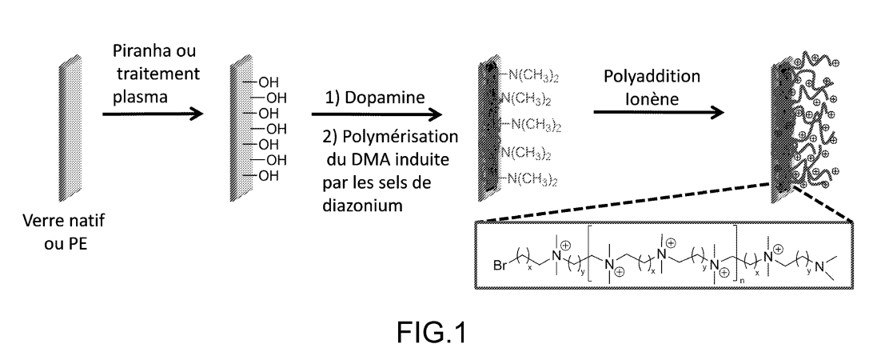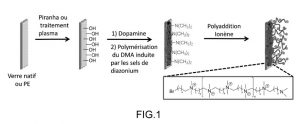La présente invention concerne un procédé pour conférer des propriétés bactériostatiques ou bactéricides à la surface d'un objet consistant à (a) fournir un objet dont la surface présente des groupements comprenant au moins un atome d'oxygène; (b) déposer, sur la surface fournie lors de l'étape (a), un revêtement à base de polymères de polydopamine ou d'un de ses dérivés, portant au moins une fonction -Y avec Y représentant un atome d'halogène ou une fonction — N(R11)(R12) avec Rll et R12, identiques ou différents, représentant un atome d'hydrogène, un groupe alkyle éventuellement substitué ou un groupe aryle éventuellement substitué; et (c) mettre en contact la surface revêtue obtenue suite à ladite étape (b) avec une solution contenant au moins un dihalogène et au moins une diamine à une température supérieure à la température ambiante, moyennant quoi un revêtement à base de polymères de polyionène est greffé, de façon covalente, sur ladite surface revêtue obtenue suite à ladite étape (b). La présente invention concerne également l'objet ainsi obtenu et ses utilisations notamment pour emballer et/ou conserver les produits alimentaires frais mais aussi pour purifier ou décontaminer une solution ou une surface.

Process for preparing a surface with bacteriostatic activity and surface thus prepared (WIPO link)
The present invention concerns a process for imparting bacteriostatic or bactericidal properties to the surface of an object, which consists in (a) providing an object of which the surface bears groups comprising at least one oxygen atom; (b) applying, to the surface provided in step (a), a coating based on polymers of polydopamine or a derivative thereof carrying at least one function -Y, where Y is a halogen atom or a function -N(R11)(R12) in which R11 and R12 are identical or different and are a hydrogen atom, an optionally substituted alkyl group or an optionally substituted aryl group; and (c) contacting the coated surface obtained after step (b) with a solution containing at least one dihalogen and at least one diamine at a temperature greater than ambient temperature, whereby a polyionene polymer-based coating is grafted covalently to said coated surface obtained after step (b). The present invention also concerns the object thus obtained and uses thereof particularly for packaging and/or preserving fresh food products but also for purifying or decontaminating a solution or a surface.
Auteurs : Géraldine Carrot (NIMBE/LICSEN), Marie-Noëlle Bellon-Fontaine, Sarah Bernardi.


